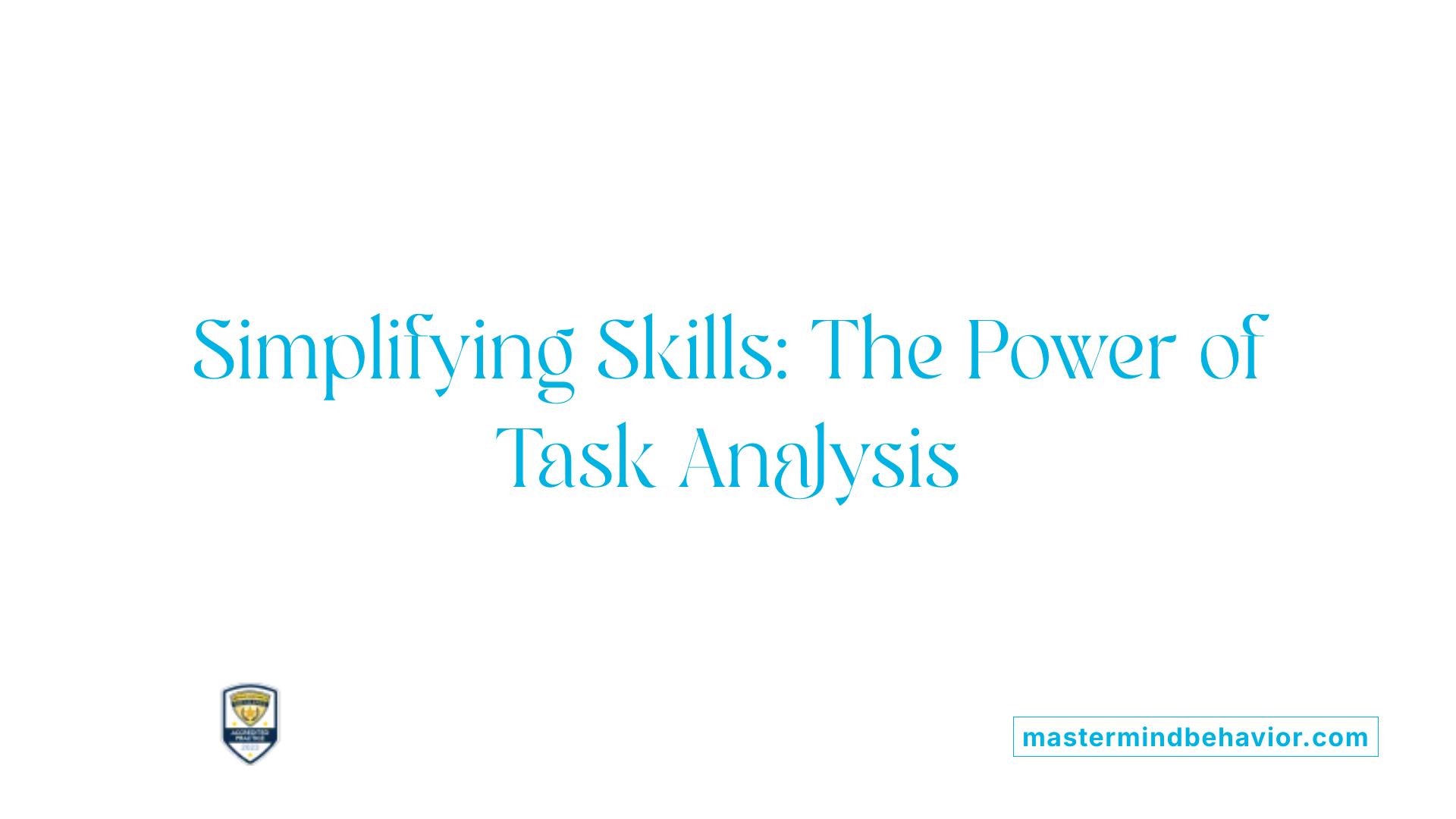Teaching Planning And Organization With ABA Tools

Understanding ABA in Autism Support
Applied Behavior Analysis (ABA) therapy stands as a cornerstone in supporting individuals with Autism Spectrum Disorder (ASD), aiming to cultivate essential life skills through scientifically grounded behavioral interventions. This article explores how ABA tools facilitate the teaching of planning and organization, key components in promoting independence and quality of life for children with autism.
What is Applied Behavior Analysis (ABA) Therapy?

Definition of ABA therapy
Applied Behavior Analysis (ABA) therapy is a science-based intervention that uses behavioral principles to improve socially significant skills. It focuses on understanding how environment influences behavior and applies techniques like reinforcement and prompting to teach new skills and reduce problematic behaviors.
Principles of behavior analysis
ABA relies on principles such as manipulating antecedents (environmental triggers) and consequences (reinforcements or punishments) to influence behavior. Positive reinforcement adds a preferred reward to increase a behavior, while negative reinforcement removes an unpleasant stimulus to encourage behavior. Punishment seeks to decrease undesired behaviors. Systematic data collection and analysis guide progress and intervention adjustments.
Role in autism treatment
ABA is widely used for children with Autism Spectrum Disorder (ASD) to enhance communication, social interaction, daily living, and self-help skills. It is considered a gold-standard treatment, providing individualized programs that promote independence and improve quality of life. Early and intensive ABA therapy is linked to significant gains in adaptive behavior and language development.
Techniques used in ABA such as discrete trial training
One common technique within ABA is Discrete Trial Training (DTT), which breaks down skills into small, manageable steps. Through prompting and reinforcement, children learn each step systematically, facilitating mastery. Other approaches include natural environment teaching and pivotal response treatment, offering versatile strategies to meet diverse learner needs across settings like homes, schools, and communities.
Core Goals of ABA Therapy for Autism

What are the primary goals of ABA therapy for individuals with autism?
Applied Behavior Analysis (ABA) therapy is designed to support children with autism by focusing on enhancing communication, social interactions, and learning abilities. A main objective is to develop the child’s verbal and non-verbal communication skills to enable clearer and more effective exchanges.
ABA aims to improve social and learning skills by teaching new behaviors and reinforcing positive habits. It uses structured techniques like positive reinforcement and systematic data collection to tailor the intervention to each child’s unique needs.
Reducing problematic behaviors that negatively impact learning or safety is also a central focus. ABA targets behaviors such as aggression or self-injury and replaces them with appropriate, socially acceptable actions.
Ultimately, ABA therapy promotes independence by teaching essential daily living skills—such as self-care and social participation—that improve quality of life. This individualized approach supports children in becoming more autonomous and better integrated within their homes, schools, and communities.
Who Provides ABA Therapy? Qualifications and Expertise

Types of ABA Professionals
ABA therapy is delivered by a range of trained professionals. The primary providers are Board Certified Behavior Analysts (BCBAs), who design and oversee intervention plans. Registered Behavior Technicians (RBTs) implement these plans under supervision. Other credentialed specialists with training in Applied Behavior Analysis also contribute to therapy sessions.
Training and Certification Requirements
BCBAs generally hold a master's degree and complete supervised fieldwork before passing a comprehensive certification exam, overseen by the Behavior Analyst Certification Board (BACB). There are also internationally recognized certifications such as the Qualified Autism Behavior Analyst (QABA), which affirm specialized knowledge in autism and ABA techniques. RBTs must complete specific training and certification to practice effectively.
Settings in Which ABA Is Provided
ABA therapists work across diverse environments, including schools, healthcare centers, private clinics, and homes. Their presence extends to research institutions and community programs. This versatility ensures therapy can be tailored and accessed according to individual needs and contexts.
Professional Standards and Ethics
Practitioners follow strict ethical codes established by credentialing organizations. These standards promote professionalism, protect client welfare, and guide data-driven treatment planning. Adherence to these guidelines ensures responsible and effective therapy delivery aimed at enhancing independence and quality of life for individuals with autism.
Measuring Success in ABA Therapy: Data-Driven Outcomes

Methods of Data Collection in ABA
Data collection is a crucial part of ABA therapy, allowing for precise measurement of behavioral changes. Therapists document behaviors using various methods tailored to the individual's skills and therapy goals. Common techniques include counting instances of a behavior, noting the duration, or marking intervals when the behavior occurs.
Frequency Counts and Interval Recordings
Frequency counts track the exact number of times a specific behavior or skill happens, giving a clear measure of increases or decreases over sessions. Interval recording breaks observation into time segments, noting whether the behavior occurred in each period, which is helpful for continuous behaviors.
Use of Graphs for Progress Visualization
Collected data is often displayed in graphs, providing visual representation of progress that helps therapists, families, and educators quickly understand improvements or identify areas needing adjustment. These graphs allow easy comparisons between baseline and ongoing performance.
Adjusting Treatment Based on Data
Therapy plans in ABA are dynamic; data analysis informs necessary modifications to intervention strategies. If target behaviors are not improving as expected, therapists refine the approach by changing reinforcement techniques, task complexity, or teaching methods to better support the learner's progress.
How is the effectiveness of ABA therapy measured in individuals with autism?
The effectiveness of ABA therapy is measured through rigorous and ongoing data collection of behaviors and skills. Using tools like frequency counts and interval recordings, therapists track progress to evaluate if treatment goals are met. Graphical summaries illustrate trends and aid decision-making. Through this continuous monitoring, therapeutic interventions are adjusted to stay personalized and effective, ensuring improvements in communication, social skills, and daily living activities are achieved over time.
The Role of Task Analysis in Teaching Planning and Organization

What Is Task Analysis and Why Is It Important?
Task analysis is a teaching strategy used widely in Applied Behavior Analysis (ABA) therapy for children with Autism Spectrum Disorder (ASD). It involves breaking down complex activities into smaller, manageable steps that a child can learn one at a time. This method simplifies learning by focusing on one piece at a time, which is especially helpful for children who face challenges with planning and organizing tasks.
How Are Complex Activities Broken Down?
When an activity is broken down using task analysis, each task is divided into sequential steps. For example, getting dressed might be split into steps like "pick up pants," "put one leg in," and "pull pants up." This approach can use different techniques such as forward chaining, where learning starts at the first step and moves forward, or backward chaining, which begins with the last step and works backward. Such breakdown ensures children build confidence as they master each step.
Where Is Task Analysis Most Often Applied?
One of the primary uses of task analysis in ABA is teaching daily living skills that foster independence—such as washing hands, brushing teeth, dressing, eating, and laundry. These skills are essential for children with ASD to manage self-care and participate more fully in home, school, and community life.
How Do Visual Supports Help in Mastering Tasks?
Visual supports like pictures, visual schedules, and social stories complement task analysis by providing clear cues for each step. These supports help children understand what to do next, maintain focus, and successfully complete tasks independently. They also assist generalization, allowing the child to perform learned activities across different settings.
Task analysis, backed by systematic instruction and consistency, equips children with the tools to effectively plan, organize, and complete everyday activities, significantly enhancing their independence and confidence.
Techniques Within Task Analysis: Chaining and Shaping
What is Forward and Backward Chaining?
Forward chaining is a teaching technique where instruction begins with the first step of a task and progresses step-by-step until the entire sequence is learned. For example, when teaching a child with ASD to put on pants, the learner masters pulling up the pants before moving on to the next step like securing the waistband. In contrast, backward chaining starts with the last step of the task and moves backwards. This method often provides immediate reinforcement for completing the task, such as fastening the pants after the teacher has helped with previous steps.
How Does Shaping Work in ABA?
Shaping involves gradually modifying behaviors by reinforcing closer and closer approximations to the desired skill. Instead of expecting the full behavior at once, small steps toward the target behavior are rewarded. For children with ASD, shaping can be used to develop communication skills, like encouraging increasingly clear vocalizations or gestures that approximate words.
Examples in Teaching Self-Help and Social Skills
These techniques are applied to a range of daily living skills and social behaviors. For instance, chaining helps teach toothbrushing by breaking the routine into steps, from applying toothpaste to rinsing. Shaping may support learning greetings by reinforcing attempts to say "hello" or wave. Tasks like folding towels, eating yogurt independently, or managing hygiene routines become manageable when broken down and reinforced through these methods.
Adaptability of Chaining and Shaping
Chaining and shaping are flexible and can be tailored to individual learning needs. They are effective across settings—from classrooms to homes and community environments. Visual supports, such as schedules or social stories, often accompany these techniques to enhance understanding and generalization to new contexts.
By combining chaining and shaping within task analysis, ABA therapy fosters independence and confidence in children with ASD, promoting meaningful skill acquisition through systematic, personalized instruction.
Systematic Instruction and Individualization in ABA Planning
Why is consistency important in teaching methods?
Consistency plays a vital role in ABA therapy, especially within task analysis. Delivering lessons and interventions in a systematic, predictable manner helps children with Autism Spectrum Disorder (ASD) feel secure and better understand expectations. This clear structure reduces confusion, enabling learners to build upon mastered steps reliably and transition smoothly through complex skills.
How are learning experiences tailored for each individual?
Individualization is essential in ABA because every child with ASD has unique strengths, challenges, and preferences. Initial assessments identify skill levels and personal needs. Based on this data, practitioners customize task analyses and intervention strategies to align with each student's specific abilities, which maximizes engagement and effectiveness.
What is the importance of assessment and initial skill evaluation?
Assessment provides the foundation for creating meaningful treatment goals by pinpointing which skills the learner has already acquired and which require development. Through systematic skill evaluations, practitioners gather necessary information to design interventions that are both realistic and challenging, ensuring progress.
How are effective intervention goals created?
Intervention goals are crafted from assessment outcomes and focus on socially significant behaviors that support independence and quality of life. Clear, measurable objectives outline expected behaviors and guide systematic data collection. This ensures consistent monitoring and necessary modifications to the treatment plan, facilitating continuous improvement.
By combining consistency in teaching, individualized learning plans, thorough assessments, and well-defined goals, ABA programs use systematic instruction to empower children with ASD toward meaningful skill acquisition and greater autonomy.
Practical Applications: Using Task Analysis for Daily Living Skills
Teaching Hygiene Routines Like Brushing Teeth
Task analysis is highly effective in teaching essential hygiene routines such as brushing teeth and washing hands. By breaking down these routines into manageable steps, children with Autism Spectrum Disorder (ASD) can learn each part systematically. Visual supports often accompany these steps to help children understand and remember the sequence, boosting both mastery and confidence.
Dressing and Eating Skills
Complex activities like dressing and eating can be overwhelming for children with ASD. Task analysis addresses this by dividing these activities into simple, clear steps. For example, putting on pants can be taught through forward or backward chaining, where each step is mastered before moving on. Similarly, eating skills like consuming yogurt are broken into steps to promote independence and reduce frustration.
Household Chores Such as Folding Towels and Laundry
Task analysis extends beyond personal care into household chores like folding towels and doing laundry. By teaching these tasks step-by-step, children can develop valuable self-help skills that contribute to their long-term independence and participation in family routines.
Improving Independence Through Structured Steps
The core strength of task analysis lies in its systematic nature—consistency, individualized teaching, and breaking down complex tasks into achievable components. This structured approach fosters autonomy in daily living skills, empowering children with autism to perform activities independently and enhancing their overall quality of life.
Using task analysis within Applied Behavior Analysis (ABA) settings ensures that each child's unique needs and abilities are addressed, making skill acquisition both efficient and meaningful across various environments like home, school, and community.
Forward vs. Backward Chaining: Strategies and Benefits
Starting Points and Progression in Chaining
Forward chaining begins with teaching the initial step of a task and then moves sequentially through each subsequent step. The learner masters one step at a time, progressing forward until the entire task is learned. Backward chaining takes the opposite approach, starting with the last step. The instructor completes all steps except the final one, which the child learns first, then moves backwards step-by-step until the first step is mastered.
When to Use Forward or Backward Chaining
Forward chaining works well when the early steps are simple and important to understand first, fostering routine building. Backward chaining is especially effective for tasks where the final step provides immediate reinforcement, such as finishing dressing or washing hands, boosting motivation by ending the task successfully.
Facilitating Confidence and Mastery
Both chaining methods help break down complex skills into manageable segments, making learning less overwhelming. Backward chaining often helps build confidence quickly since the learner immediately completes a meaningful final step. Forward chaining enables consistent building from the start, supporting steady mastery.
Supporting Skill Generalization
Task analysis with chaining techniques, combined with visual supports, supports skill generalization beyond therapy sessions. Practicing steps in natural settings like home or school encourages independence. Techniques like social stories and visual schedules further reinforce task completion in varied environments, aiding the transfer of skills across contexts.
Supporting Skill Generalization with Visual Schedules and Social Stories
Using Visual Supports for Task Completion
Visual schedules are powerful aids in Applied Behavior Analysis (ABA) that help children with Autism Spectrum Disorder (ASD) follow task sequences more independently. These visual cues provide clear, step-by-step guidance, simplifying complex activities by showing what comes next, which boosts confidence and reduces frustration.
Social Stories to Explain Sequences
Social stories complement visual schedules by describing social situations and task sequences in simple, relatable language. They prepare children for what to expect during various activities, promoting understanding and smoother transitions through clear explanations of each step.
Aiding Transition Across Settings
One of the challenges for children with ASD is applying learned skills beyond structured therapy. Visual schedules and social stories support skill generalization by offering consistent cues interpretable in different environments, such as home, school, or community settings. This consistency helps children maintain their accomplishments and adapt them to real-life situations.
Reinforcing Learned Behaviors Outside Therapy
These tools also serve to reinforce behaviors outside the clinical setting, ensuring that skills practiced during therapy are retained and naturally integrated into daily living. By extending support beyond therapy, visual schedules and social stories enhance independence and improve overall quality of life for children with autism.
The Scientific Foundation of ABA: Behavioral Principles in Practice
What Are Antecedents and Consequences in ABA?
Antecedents are environmental events or triggers that occur before a behavior, setting the stage for that behavior to happen. Consequences follow the behavior and can either increase or decrease its likelihood in the future. Understanding these elements allows therapists to guide behavior change effectively.
How Do Reinforcement and Punishment Work?
In ABA, reinforcement strengthens a behavior, making it more likely to occur. This can be positive reinforcement, such as adding praise or a favorite item, or negative reinforcement, which involves removing an unpleasant stimulus. Conversely, punishment is used to reduce or eliminate a behavior, although ABA prioritizes reinforcement to encourage positive behaviors whenever possible.
How Does ABA Increase or Decrease Targeted Behaviors?
ABA techniques focus on systematically increasing socially important behaviors while decreasing undesired ones. Through clear intervention goals and ongoing data collection, ABA programs apply reinforcements and sometimes punishments strategically to modify behavior. This systematic approach ensures that behavior changes are meaningful and sustainable.
What Evidence Supports ABA as a Treatment Modality?
ABA is widely recognized as the most scientifically validated treatment for individuals with Autism Spectrum Disorder. Its basis in behavioral science, combined with rigorous data collection and analysis, has established ABA as an effective therapy to improve social interaction, communication, and daily living skills. It is used by professionals in diverse settings, reinforcing its broad applicability and success.
Expanding ABA Use Beyond Autism: Versatility of the Approach
How is ABA used in education, healthcare, and research?
Applied Behavior Analysis (ABA) extends well beyond autism therapy into diverse fields. In education, ABA techniques support children with varying needs by enhancing academic and social skills through structured interventions and data-driven adjustments. Healthcare professionals use ABA principles to improve patient compliance with medical routines and foster adaptive behaviors, while research settings apply ABA to study behavior patterns and test intervention effectiveness.
What are some unique applications of ABA?
ABA's flexibility shines in areas like animal training, where behavioral principles teach desired responses and reduce problem behaviors. In medical procedures, ABA helps patients cooperate with treatments by shaping compliance behaviors and managing anxiety. Workplace safety programs utilize ABA by reinforcing safe behaviors and reducing risks through systematic observation and feedback.
How do ABA techniques adapt to different populations?
ABA methods are highly adaptable, catering to individuals across age groups and ability levels. Techniques such as discrete trial training and task analysis can be customized for children, adults, or animals, addressing unique learning styles and environmental contexts. This adaptability ensures that behavior analytic principles remain effective regardless of the population.
Why are behavior analytic principles broadly relevant?
The core principles of ABA—manipulating antecedents and consequences to influence behavior—are universally applicable. Whether teaching daily living skills, improving workplace habits, or training animals, these principles offer a scientific framework for behavior change that is evidence-based and measurable. This broad relevance makes ABA a valuable approach across multiple disciplines and settings.
Discrete Trial Training: A Structured Teaching Strategy
What is Discrete Trial Training (DTT)?
Discrete Trial Training (DTT) is a teaching method grounded in Applied Behavior Analysis (ABA) principles. The approach systematically breaks down complex skills into smaller, manageable units, making it easier for children with Autism Spectrum Disorder (ASD) to learn new behaviors.
How Does DTT Break Skills into Small Units?
Skills are divided into discrete, teachable steps that focus on one specific behavior or task at a time. This structured division allows instructors to teach, prompt, and reinforce each component thoroughly before moving to the next step.
What Role Do Prompts and Reinforcement Play?
Prompts are cues or assistance provided to encourage the correct response. They gradually decrease as the learner gains independence. Reinforcement follows a correct response and can be positive—such as praise or a preferred item—to increase the likelihood of the behavior reoccurring. This consistent use of prompts and reinforcement supports effective skill acquisition.
How is Progress Tracked in DTT?
Data collection is integral to DTT, with instructors recording responses after each trial. This systematic tracking helps analyze progress and guides decision-making, allowing adjustments to teaching strategies if necessary.
How Does DTT Integrate with Other ABA Techniques?
DTT is often part of a broader ABA program. It complements techniques like task analysis, which breaks down daily living skills into sequential steps, and chaining methods (both forward and backward) to teach complex behaviors gradually. Visual supports and social stories may also accompany DTT to aid generalization outside structured sessions.
Through its structured, data-driven nature, Discrete Trial Training remains a powerful strategy within ABA to teach important skills, enhancing independence and quality of life for individuals with ASD.
Building Confidence and Autonomy Through ABA-Based Planning
Role of planning and organization in independence
Planning and organization are vital in fostering independence, especially for children with Autism Spectrum Disorder (ASD). When complex tasks are broken down into manageable steps, learners can better understand and complete activities without constant assistance. This structure nurtures self-reliance by providing clear expectations and a sense of accomplishment as each step is mastered.
How ABA tools support executive functioning
Applied Behavior Analysis (ABA) offers powerful tools that support executive functioning skills such as planning, sequencing, and task initiation. Techniques like task analysis break down daily routines into sequential steps, while visual schedules and social stories help prepare learners for transitions and upcoming activities. These supports enable children to manage their behaviors and organize their tasks more effectively.
Encouraging self-initiated activities
ABA-based interventions emphasize teaching not only how to perform tasks but also when and why to initiate them independently. Through consistent reinforcement and gradual fading of prompts, children are encouraged to initiate activities on their own. This progression boosts their confidence and motivates them to engage in daily living skills without direct supervision.
Long-term benefits for quality of life
By embedding planning and organizational strategies within ABA therapy, children with ASD develop a foundation for lifelong autonomy. Mastering routine skills such as hygiene, dressing, and household chores contributes significantly to their quality of life. These enhancements reduce caregiver reliance and promote inclusion within home, school, and community environments, fostering a more fulfilling and independent future.
Fostering Independence with ABA Tools
ABA therapy offers a scientifically validated framework for teaching planning and organization skills to individuals with autism. Through methods like task analysis, chaining, and systematic instruction, ABA empowers children to master daily living skills essential for independence. The ongoing, data-driven evaluation ensures interventions remain effective and tailored, while the versatility of ABA tools extends their benefits across diverse settings. Ultimately, teaching planning and organization with ABA supports not only skill acquisition but also confidence and autonomy, enabling individuals with autism to thrive in their communities and lead fulfilling lives.
References
- Task Analysis in ABA Therapy: Strategies and Examples
- What is Applied Behavior Analysis?
- Ongoing Assessment in ABA Therapy: A Data-Driven ...
- Applied Behavior Analysis (ABA)
- ABA Therapy Goals: 25 Practical Examples & Timelines
- Applied Behavior Analysis (ABA)
- ABA Therapy Goals: Key Objectives for Children with Autism
- Applied Behavior Analysis (ABA)
Recent articles

Teaching Planning And Organization With ABA Tools
Enhancing Independence Through Structured ABA Strategies

Teaching Planning And Sequencing Using ABA Therapy
Enhancing Learning and Life Skills Through ABA-Based Planning and Sequencing

How ABA Therapy Encourages Healthy Risk Assessment Skills
Enhancing Decision-Making and Safety Awareness Through ABA Therapy

How ABA Therapy Improves Classroom Group Participation
Enhancing Classroom Dynamics Through Applied Behavior Analysis

ABA Therapy To Reduce Disruptions During Group Activities
Enhancing Group Participation: The Role of ABA Therapy in Managing Behavioral Disruptions

How ABA Therapy Encourages Safe Risk Taking In Community Settings
Empowering Autistic Individuals Through Structured Community Engagement



